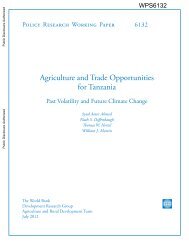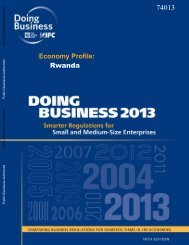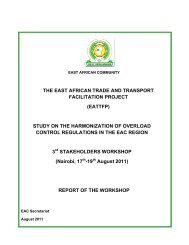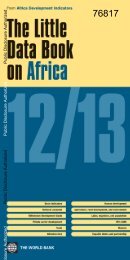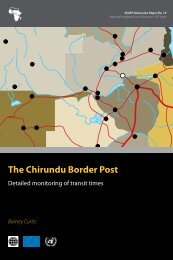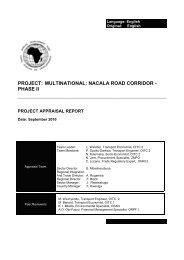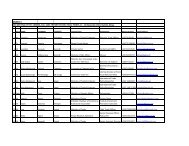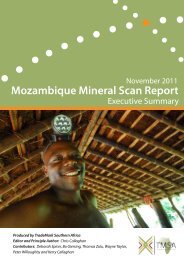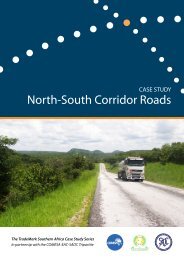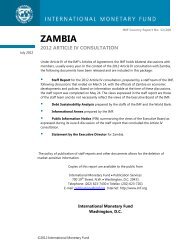Plant Health, Climate Change and Trade - TradeMark Southern Africa
Plant Health, Climate Change and Trade - TradeMark Southern Africa
Plant Health, Climate Change and Trade - TradeMark Southern Africa
You also want an ePaper? Increase the reach of your titles
YUMPU automatically turns print PDFs into web optimized ePapers that Google loves.
6 <br />
A study done in 2011 by the International Center for Tropical Agriculture (CIAT) indicates a<br />
high potential for combined outbreaks of whitefly, green mite, CMD <strong>and</strong> CBSD in <strong>Africa</strong>'s Rift<br />
Valley that could lead to a collapse in production <strong>and</strong> ultimately threaten food security in the<br />
region. Scientists are working on the development of cassava varieties that are resistant to<br />
whitefly, green mite <strong>and</strong> CMD. Further studies in taxonomy <strong>and</strong> dispersal patterns of the<br />
disease vectors are required on local, l<strong>and</strong>scape <strong>and</strong> regional scales to determine<br />
appropriate early warning <strong>and</strong> management strategies <strong>and</strong> policies that would control the<br />
pest <strong>and</strong> disease distribution to unaffected areas. Scientists have monitored the spread of<br />
CMD <strong>and</strong> CBSD in central <strong>and</strong> East <strong>Africa</strong> for several years but costs have been high <strong>and</strong><br />
annual visits to the region barely kept pace with the spread. And so the Digital Early<br />
Warning Network (DEWN) was established <strong>and</strong> piloted in Tanzania. Farmer groups were<br />
involved <strong>and</strong> information received was used to generate maps <strong>and</strong> allow research teams to<br />
concentrate mitigation efforts in areas where new outbreaks occurred. In 2010 it was<br />
decided to exp<strong>and</strong> the project to Rw<strong>and</strong>a.<br />
The movement of plant propagation material used in agricultural research, crop<br />
diversification, food production <strong>and</strong> commercial trade pose significant phytosanitary risks.<br />
New pests <strong>and</strong> disease may easily result in outbreaks of epidemic proportions when<br />
introduced into areas where there is no resistance or competition. In the 1970's the cassava<br />
green mite was accidentally introduced into <strong>Africa</strong> <strong>and</strong> spread to almost all cassava<br />
producing regions resulting in losses of 30-50 percent. In 1993 a biological control agent<br />
from Latin America was introduced to assist in its control. The accidental introduction of<br />
bunchy top virus affected more than 3000ha banana production in Malawi <strong>and</strong> completely<br />
destroyed production in Nkhota, Khota <strong>and</strong> Nkhatabay. Therefore national plant protection<br />
organisations have developed strict risk based phytosanitary measures that include visual<br />
inspection during active growth, virus-indexing, blotter testing <strong>and</strong> sedimentation essays for<br />
seeds, to prevent the introduction of pests <strong>and</strong> diseases by means of propagation material.<br />
True seeds <strong>and</strong> in-vitro propagation material are considered expensive but also the safest<br />
phytosanitary management options for exchange of propagating material. In 2007, the<br />
Great Lakes Cassava Initiative (GLCI) was implemented to ensure plant health of<br />
propagating material in Burundi, Democratic Republic of Congo, Kenya, Rw<strong>and</strong>a, Tanzania<br />
<strong>and</strong> Ug<strong>and</strong>a, especially in the light of recent p<strong>and</strong>emics of CBSD.<br />
The prevalence <strong>and</strong> spread of fruit flies in <strong>Africa</strong> will alter considerably because of climate<br />
change <strong>and</strong> will result in corresponding changes in phytosanitary regulations, intra-regional<br />
<strong>and</strong> international trade opportunities. Fruit flies are one of the world's most devastating fruit<br />
<strong>and</strong> vegetable pests <strong>and</strong> cause millions of US$ losses in crop production each year. In <strong>Africa</strong><br />
there are several species that attack crops <strong>and</strong> wild hosts. Since its first detection in Kenya<br />
in 2003, the fruit fly Bactrocera invadens has spread to at least 27 countries in <strong>Africa</strong> <strong>and</strong><br />
became a major pest of economic <strong>and</strong> quarantine concern. It is known to attack at least 46<br />
host plants, including many indigenous plant species <strong>and</strong> commercially grown crops such as<br />
mango, guava, pumpkin, melon, tomato, citrus <strong>and</strong> cashew nuts. Equatorial climates in<br />
<strong>Africa</strong> are considered most suitable for the establishment of B. invadens. The introduction<br />
<strong>and</strong> establishment of this fruit fly can severely impact on sustainable agriculture <strong>and</strong> rural<br />
livelihoods, as well as access to export markets because of its quarantine status in other<br />
countries. The detection of B. invadens in Mozambique, northern Namibia <strong>and</strong> Zambia<br />
resulted in the suspension of all host plant exports to South <strong>Africa</strong>. And for the same reason,<br />
COP 17 -‐ <strong>Trade</strong>mark <strong>Climate</strong> change impact on phytosanitary risks





